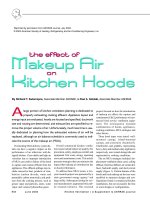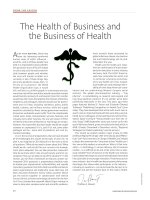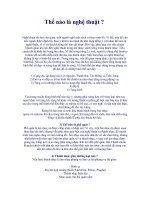Tài liệu The Health of Our Educators doc
Bạn đang xem bản rút gọn của tài liệu. Xem và tải ngay bản đầy đủ của tài liệu tại đây (2.42 MB, 199 trang )
Free download from www.hsrc
p
ress.ac.za
PreparedfortheEducationLabourRelationsCouncilbyaresearchconsortiumcomprisingtheSocialAspectsof
HIV/AIDSandHealthResearchProgrammeoftheHumanSciencesResearchCouncilandtheMedicalResearch
Council
PublishedbyHSRCPress
PrivateBagX9182,CapeTown,8000,SouthAfrica
www.hsrcpress.ac.za
©2005EducationLabourRelationsCouncil
Firstpublished2005
Allrightsreserved.Nopartofthisbookmaybereprintedorreproducedorutilisedin
anyformorbyanyelectronic,mechanical,orothermeans,includingphotocopying
andrecording,orinanyinformationstorageorretrievalsystem,withoutpermission
inwritingfromtheEducationLabourRelationsCouncil.
ISBN0-7969-2101-6
CopyeditingbyVaunCornell
TypesetbyRobinTaylor
CoverdesignbyJennyYoung
PrintmanagementbycomPress
DistributedinAfricabyBlueWeaverMarketingandDistribution
POBox30370,Tokai,CapeTown,7966,SouthAfrica
Tel:+27+21701-4477
Fax:+27+21701-7302
email:
Distributedworldwide,exceptAfrica,byIndependentPublishersGroup
814NorthFranklinStreet,Chicago,IL60610,USA
www.ipgbook.com
Toorder,calltoll-free:1-800-888-4741
Allotherenquiries,Tel:+1+312-337-0747
Fax:+1+312-337-5985
email:
Free download from www.hsrc
p
ress.ac.za
Contents
Listoftables v
Listoffigures vii
Foreword viii
Acknowledgements ix
Listofcontributors xi
Executivesummary xiv
Abbreviations xxiii
1Introduction 1
1.1Epidemiologicalmodel 5
1.1.1Independentvariables 6
1.1.2Moderators 11
1.1.3Dependentvariables 12
1.2Rationaleofthestudy 13
1.3Researchquestions 13
1.4Objectivesofthestudy 13
2Methodology 15
2.1Researchdesign 16
2.2Instrumentsandscales 16
2.2.1Individualquestionnaires 16
2.2.2Scalesusedinthestudy 17
2.2.3Learningareas 18
2.2.4HIVtesting 20
2.3Pilotstudy 20
2.4Ethicalclearance 20
2.5Sampledesign 21
2.6Sample 22
2.7Datacollection 24
2.7.1Recruitmentandtrainingoffieldworkers 24
2.7.2Accessintoschools 24
2.7.3Qualitycontrol 25
2.7.4Needlestickinjuriestonursesduringfieldwork 26
2.7.5Datamanagement 26
2.7.6Weightingofsamples 27
2.7.7Dataanalysis 27
3Strengthsandlimitationsofthestudy 29
3.1Strengths 30
3.2Limitations 30
4Results 31
4.1Responserates 32
4.2Demographicandsocio-economiccharacteristicsofthestudysample 35
4.2.1Introduction 35
4.2.2Demographiccharacteristics 35
4.2.3Socio-economiccharacteristics 45
4.2.4Summary 52
4.3HIVprevalenceamongSouthAfricaneducators 52
4.3.1HIVprevalencebysocio-demographicfactors 53
Free download from www.hsrc
p
ress.ac.za
Thehealthofoureducators
4.3.2HIVprevalencebyprovinceanddistrict 58
4.3.3ProfileofteachersandHIVprevalence 66
4.4DeterminantsofHIV/AIDS 69
4.4.1Numberofsexualpartners 70
4.4.2AwarenessofHIVstatus 71
4.4.3Condomuse 72
4.4.4Consistentcondomuse 77
4.4.5HIV/AIDSknowledge 80
4.4.6Same-sexrelationships 83
4.4.7Agemixing 84
4.5Residence,migration,mobilityandHIVstatus 84
4.6AlcoholuseamongSouthAfricaneducators 91
4.6.1Alcoholusebysex,race,ageandmaritalstatus 91
4.6.2Alcoholuseofmaleeducatorsbysocio-economicstatus 92
4.6.3High-riskalcoholuseofmaleeducatorsbyprovince 93
4.6.4Alcoholuseandhealth-relatedqualityoflife,absenteeismfrom
workandHIVstatusamongmaleeducators 94
4.7TBprevalence 95
4.7.1Method 95
4.7.2Results 96
4.8SexuallytransmittedinfectionsandHIV 98
4.9HealthstatusofSouthAfricaneducators 99
4.9.1Educatorhealth-relatedproductivity 100
4.10Violenceineducationalinstitutions 103
4.11Potentialattritionofeducators 105
5Discussionofthefindings 113
5.1Profileofeducators 114
5.2PrevalenceofHIV 114
5.3Condomuse 120
5.4KnowledgeofHIVtransmission 123
5.5Alcoholuse 123
5.6Healthstatusandhealth-relatedproductivity 124
5.7Potentialforattrition 125
6Conclusions 127
7Recommendations 131
8Appendices 139
Appendix1:Developmentofscalesandindices 140
Appendix2:LaboratoryHIVtestingprocedures 146
Appendix3:Evaluationoftheage-sexdistributions 147
Appendix4:ReliabilityandvalidityofHIVprevalencerate,socio-demographic
profiles,coefficientofvariationandthedesigneffects 156
Appendix5:Listoffieldworksupervisors,interviewersandcoders 158
9References 165
Free download from www.hsrc
p
ress.ac.za
Thehealthofoureducators
Table2.1: Learningareasandsubjectgroups 18
Table2.2: Breakdownofthesampleofschoolsbyprovince 23
Table4.1: Responseratesofeducatorsinpublicschoolssurveyedbyprovince,South
Africa2004 33
Table4.2: Demographicandbasiccharacteristicsofthesample 36
Table4.3: Age-sexdistributionbyrace 39
Table4.4: Age-sexdistributionbyprovince 39
Table4.5: Socio-economicfactorsbyrace,SouthAfricaneducators2004 47
Table4.6: Socio-economicfactorsbysex,SouthAfricaneducators2004 48
Table4.7: Unionmembersandcharacteristics 51
Table4.8: HIVprevalencebyvariousdemographiccharacteristicsofpublicsector
educators,SouthAfrica2004 53
Table4.9: ComparisonofHIVprevalenceinSouthAfricaneducatorswiththegeneral
population 55
Table4.10: OverallHIVprevalenceamongeducatorsbysocio-economicstatus,
SouthAfrica2004 58
Table4.11: OverallHIVprevalenceamongeducatorsbyprovince,SouthAfrica2004 59
Table4.12: HIVprevalenceamongeducators,WesternCape 61
Table4.13: HIVprevalenceamongeducators,EasternCape 62
Table4.14: HIVprevalenceamongeducators,FreeState 62
Table4.15: HIVprevalenceamongeducators,Gauteng 63
Table4.16: HIVprevalenceamongeducators,KwaZulu-Natal 63
Table4.17: HIVprevalenceamongeducators,Limpopo 64
Table4.18: HIVprevalenceamongeducators,Mpumalanga 64
Table4.19: HIVprevalenceamongeducators,NorthWest 64
Table4.20: HIVprevalenceamongeducators,NorthernCape 65
Table4.21: AnalysisofareaswithhighHIVprevalence 65
Table4.22: DistrictswithlowHIVprevalence(under5%) 66
Table4.23: HIVprevalencebymetropolitandistrict 66
Table4.24: HIVprevalencebylearningareataught(trainedin),SouthAfrica2004 67
Table4.25: OverallHIVprevalencebytypeofeducationalinstitution,positionin
educationalsystemandyearsofteachingexperience,SouthAfrica2004 68
Table4.26: OverallHIVprevalencebyeducator’semploymentsituation,havinghousing
subsidyandmemberofmedicalaidfund,SouthAfrica2004 69
Table4.27: Numberofsexualpartnersinthepast12monthsbyrace,SouthAfrican
educators2004 70
Table4.28: Numberofsexualpartnersinthelast12monthsbyraceandsex,maleSouth
Africaneducators2004 71
Table4.29: Numberofsexualpartnersbyraceandsex,femaleSouthAfricaneducators
2004 71
Table4.30: AwarenessofHIVstatus 72
Table4.31: Condomusewithregularpartnersduringlastsexualactbydemographic
characteristicsofpubliceducators,SouthAfrica,2004 73
Table4.32: CondomuseatlastsexwithregularpartnersamongstHIV-positiveand
HIV-negativeSouthAfricaneducators,2004 75
Table4.33: Frequencyofcondomusewithregularpartnerinthepastyearamongst
HIV-positiveandHIV-negativeSouthAfricaneducators,2004 76
Table4.34: Frequencyofcondomuseinthepastyearwithregularpartnerbyawareness
ofHIVstatus(alleducators)SouthAfricaneducators,2004 76
Listoftables
v
Free download from www.hsrc
p
ress.ac.za
vi
vii
Table4.35: Frequencyofcondomuseinthepastyearwithnon-regularpartnerby
awarenessofHIVstatus(alleducators)SouthAfricaneducators,2004 77
Table4.36: Relationshipstatusandconsistencyofcondomuse 78
Table4.37: Consistentcondomusebyregularorsteadypartnerandcasualornon-
regularpartnerinthepast12months 79
Table4.38: HIV/AIDSknowledgebysex,SouthAfricaneducators,2004 81
Table4.39: SamesexrelationshipsandHIVprevalenceamongeducators,SouthAfrica
2004 83
Table4.40: ExtentofagemixingamongSouthAfricaneducatorsandHIV
prevalence,2004 84
Table4.41: Residence,migrationandmobilitybyraceandsexandotherdemographic
variables,SouthAfricaneducators,2004 85
Table4.42: ResidenceandHIVstatus,SouthAfricaneducators,2004 87
Table4.43: MigrationandHIVstatus,SouthAfricaneducators,2004 88
Table4.44: MobilityandHIVstatus 89
Table4.45: Logisticregressionbetweensocio-economicstatus,sexualbehaviourandHIV
status 90
Table4.46: AlcoholusebySouthAfricaneducatorsinpublicschoolsbysexandrace,
2004 92
Table4.47: Alcoholuseofmaleeducatorsbysocio-economicstatus,SouthAfrica
2004 92
Table4.48: High-riskdrinkingamongmaleeducatorsperprovince,SouthAfrica2004 93
Table4.49: Alcoholuseofmaleeducatorsbyunhealthydays,SouthAfrica2004 94
Table4.50: Alcoholuseandself-ratedabsenteeismfromworkin2003 94
Table4.51: AlcoholordrugusebeforelastsexandHIVstatus 95
Table4.52: PrevalenceofHIVbyself-reportedhistoryofhavingasexuallytransmitted
infection 98
Table4.53: Sizeofpopulationofeducatorssufferingfromchronicconditionsthatmay
affecthealthandmaycontributetoabsenteeism 100
Table4.54: Absenteeismandpresenteeism(unhealthydays)byeightcommonchronic
illnesses(sevenself-reportedillnessesandHIVstatus)andsubstanceuse,
2003 101
Table4.55: Health-relatedproductivityandwork-relatedvariables(workplacemorale,
intentiontoquit,jobsatisfaction,andjobstress),2003 102
Table4.56: Educatorsupportandabsenteeismandpresenteeism(unhealthydays) 103
Table4.57: Violenceexperiencedoroccurredineducationalinstitutioninthepast
12months 104
Table4.58: Violenceindexbylocality,typeofschool,province 104
Table4.59: Violenceindexbyself-ratedmoraleateducationalinstitutionandintentionto
leavetheeducationprofession 105
Table4.60: Intentiontoleavebysocio-demographicsandlearningareas 106
Table4.61: IntentiontoleavebyHIVstatus,localityandjobexperience 108
Table4.62: Factorsofjobsatisfactionandintentiontoleaveteaching 109
Table4.63: Factorsofjobstressandintentiontoleaveteaching 111
TableA1: Itemsandfactorloadingsforthejobsatisfactionscale 141
TableA2: Itemsandfactorloadingsforthejobstressscale 142
TableA3: Medianage(years)ofeducatorsinthe2003GHSand2004ELRC
surveys 149
TableA4: Overallsexratiosofeducators 154
Thehealthofoureducators
Free download from www.hsrc
p
ress.ac.za
vi
vii
Figure1.1: Epidemiologicalmodel 5
Figure2.1: Stepsinthesampledesign 21
Figure2.2: Stepsinthedrawingofthesample 22
Figure2.3: Schoolsample 23
Figure2.4: Stepsindataprocessing 26
Figure2.5: Stepsusedforweightingofthesample 27
Figure4.1: Flowofdatacollection 34
Figure4.2: Percentageofeducatorsincurrentmaritalstatuscategory 41
Figure4.3: Currentlymarriedmaleeducatorsbyageandprovince 41
Figure4.4: Currentlymarriedfemaleeducatorsbyageandprovince 42
Figure4.5: Nevermarriedmaleeducatorsbyageandprovince 42
Figure4.6: Nevermarriedfemaleeducatorsbyageandprovince 43
Figure4.7: CurrentlyandnevermarriedAfricanfemaleeducatorspregnantin
thelast12months 43
Figure4.8: Currentlyandnevermarriedwhitefemaleeducatorspregnantoverlast
12months 44
Figure4.9: Currentlyandnevermarriedcolouredfemaleeducatorspregnantover
last12months 44
Figure4.10: CurrentlyandnevermarriedIndian/Asianfemaleeducatorspregnantover
last12months 44
Figure4.11: Highesteducationalqualificationofeducatorsbyprovince 45
Figure4.12: Currentannualgrossincomeofeducatorsbyrace 46
Figure4.13: Percentageofeducatorswithhousingsubsidyandmembersofmedical
aidfund 50
Figure4.14: Numberofchildrendependentoneducatorsbyprovince 50
Figure4.15: HIVprevalencebyageandsex,SouthAfricanpublicsectoreducators,
2004 54
Figure4.16: HIVprevalencebyageandsexinAfricaneducators,SouthAfrica 57
Figure4.17: ComparisonofHIVprevalenceamongwomen:educators,antenataland
populationsurveydata,SouthAfrica 59
Figure4.18: DistrictcouncilsofSouthAfrica 60
FigureA1: Reportedsingle-yearagedistributionofeducatorsinthegeneral
populationandtheELRCstudy,males 150
FigureA2: Reportedsingle-yearagedistributionofeducatorsinthegeneral
populationandtheELRCstudy,females 150
FigureA3: Five-yearagedistributionofmaleeducators,GHS2003andELRC
2004 152
FigureA4: Five-yearagedistributionoffemaleeducators,GHS2003andELRC
2004 152
Listoffigures
Free download from www.hsrc
p
ress.ac.za
viii
ix
Foreword
Thenewmillenniumhasheraldedinseveralchallengesatthedoorofeducatorsand
educationingeneral.However,nonehavebeenasdauntingorascatastrophicastheHIV/
AIDSpandemic.EducationisoneofourmostpowerfulweaponsagainstHIV/AIDS;however,
itisalsoasectorthatislabourintensiveandthereforemostvulnerabletothedisease.
Ourchildrenareourhopeforthefuture.Ourteachersmouldthemintoinstruments
ofsocialcapital,thewellspringofourfuture.Withouttheinculcationoftheskillsand
competenciesthatenhancehumanpotentialnodevelopingcountrycanhopetostart
buildingthebasicsocialinfrastructurethatisaprerequisiteforgeneratingthelevels
ofeconomicgrowththatunderpinsustainabledevelopment.InSouthAfrica’scasethe
needtotimeouslyaddresstheinequitiesentrenchedbygenerationsofapartheidismore
urgent.Thusthecountry’steachersaretheprimaryagentsofsocialchange.
Theefficacyofoureducationalsystemdependsontheefficacyofourteachers.Tothe
extentthatitsranksaredepletedbyteacherdeaths,illness,absenteeism,orchronic
disabilitiesduetoHIV/AIDS,theeducationofourchildrenisthenputatrisk,levelsof
accesstoeducationarereduced,standardsofeducationattainedlowered,opportunities
forsecondaryandtertiaryadvancementreduced,jobskillsforfeited,andsocietystunted.
SouthAfricacanillaffordtoallowadiseaselikeHIV/AIDSandchronicdiseasesto
depleteitsteacherworkforce.Theseriousnessofsuchanimpendingcatastrophe
thereforegalvanisedtheDepartmentofEducation(National,Provincial,District),South
AfricanCouncilofEducatorsandtheunions–SouthAfricanDemocraticTeachers’
Union,theNationalProfessionalTeachers’OrganisationofSouthAfrica,SuidAfrikaanse
Onderwysers’UnieandtheNationalTeachers’UnionsofSouthAfrica–aswellasthe
HumanSciencesResearchCouncil-ledconsortiumanditspartner,theMedicalResearch
Council,undertheauspicesoftheEducationLabourRelationsCounciltotakeprogressive
actioninascertainingtheprevalenceandimpactofHIV/AIDSandtuberculosisonthe
teacherworkforce.ThisstudywasoriginallyinitiatedseparatelybytheSouthAfrican
DemocraticTeachers’Union,theNationalDepartmentofEducationandotherteacher
unionsandisaprimeexampleofhowkeystakeholderscanbenefitbyworkingtogether
forthecommongoodoftheirconstituency.ThemanagementofHIV/AIDSdemands
amulti-sectoralresponseofpartnershipsandcollaborationofgovernment,organised
labour,non-governmentalorganisationsandsoforth.TheEducationLabourRelations
CouncilandtheHumanSciencesResearchCouncilwereinstrumentalinfacilitatingthis
consensus.TheHumanSciencesResearchCouncilwasabletoharnesstheenergiesofall
thepartners,notablytheMedicalResearchCouncilandothermembersoftheTechnical
TaskTeam,throughouttheresearchprocessandwasreceptivetoideasgeneratedbythe
stakeholderswithoutcompromisingtheintegrityofresearch.Consequentlyitwaspossible
toco-generateknowledgethatinformspolicy.NowthereportistabledtotheEducation
LabourRelationsCouncilandthepartnerswillberequiredtoexaminethereportand
debatethepolicyrecommendations.Thevalueofthisinitiativewillbejudgedbythe
extenttowhichinterventionsareimplemented.
IfSouthAfricacannotcurtailthelevelsofinfectionandprogressionofHIV/AIDSamong
itsteacherstheconsequenceswillbebequeathednotjusttothepresentgenerationof
learnersbuttofuturelearners,addingimmeasurablyandunnecessarilytopovertyand
socialstagnationinfuturedecades.
DhayaGovender GeneralSecretaryandCo-ChairoftheTechnicalTaskTeam
EducationLabourRelationsCouncil
Free download from www.hsrc
p
ress.ac.za
viii
ix
Thisresearchstudywasacollaborativeendeavourinvolvingmanypeoplefrombeginning
toend.Althoughnotanexhaustivelist,wewishtothankthefollowingpeopleand
organisationsfortheirparticipationinonewayoranotherinthisstudy:
•ThethenMinisterofEducation,ProfessorKaderAsmal,MP,andhistwoadvisors,
DrAlanTaylorandMsKgobatiMagome,aswellastheSouthAfricanDemocratic
Teachers’Unionleadershipwhowereinvolvedintheinitialdevelopmentoftermsof
referenceandthenational,provincialanddistrictofficialsforencouragingeducators
toparticipate;
•TheeducatorsofSouthAfrica,withoutwhosegenerosityandtimethissurveywould
nothavebeenpossible.Inparticular,wewishtothanktheprincipalsof
participatingschoolsforallowingusintotheirbusyschoolprogrammestoconduct
thestudy;
•TheDepartmentofEducation(nationalandprovincial),theSouthAfrican
DemocraticTeachers’Union,theNationalProfessionalTeachers’Organisationof
SouthAfrica,theSuidAfrikaanseOnderwysers’UnieandtheSouthAfricanCouncil
ofEducationforfacilitatingentryintoschoolsandcontributingtheirideastothis
research;
•ThemembersoftheAdvisoryTaskTeam,theMinisterialCommitteeonTeacher
EducationandtheEducationLabourRelationsCouncilTechnicalTaskTeamwho
guidedtheproject,especiallyduringitsformativestages;
•TheDeansofEducationFacultiesatuniversitieswhoadvisedusonsampling
universitystudents;
•ThemembersofstaffofvariousresearchprogrammesintheHumanSciences
ResearchCouncil,including:SocialAspectsofHIV/AIDSandHealth;Surveys,
Analyses,ModellingandMapping;EmploymentandEconomicPolicyResearch;and
AssessmentTechnologyandEducationEvaluation.Inparticular,wewishtothank
DrMokubungNkomo(AssessmentTechnologyandEducationEvaluation,of
UniversityofPretoria)forfacilitatinginitialconsultationsbetweentheSouthAfrican
DemocraticTeachers’UnionandtheHumanSciencesResearchCounciloninitiating
theproject,DrStephenRule(ofSurveys,Analyses,ModellingandMapping)for
sharinghisexperienceinsurveysespeciallyonexecutingfieldwork,andMrAdlai
Davidsofthesameprogramme,forassistinginsamplingofschools.Finally,but
notleast,MrsMonicaPeretforleadingtheteamwhodidtheday-to-daydata
managementforthisstudy;
•DrJohanvanZylforcontributingtremendouslyinquestionnairedesignand
formatting;
•DrMarleneRoefs,thenationalprojectco-ordinator,forhertremendouseffortin
ensuringsmoothrunningofthefieldwork;
•Theprovincialco-ordinators:MsShantinieFrancis,MrsNomvoHenda,MsLebogang
Letlape,MsJuliaLouw,MrAyandaNqeketo,MrGeorgePetros,MrShandir
Ramlagan,MrTsilisoTamasane,MrFhumulaniThaba,MrBrianvanWyk,Mr
NhlanhlaSitholeandMsNompumeleloZungu-Dirwayi,whospentmonthsinthe
fieldarrangingschoolvisitsandmanagingday-to-dayfieldwork;
•Thenurse-supervisorsandfieldworkers,wholabouredtirelesslyandtravelledmany
kilometerstogatherthedata;
•Theprojectadministrators:MsHermienBolton,MrsMarizaneRousseau-Mareeand
MrsYolandeSheanofSocialAspectsofHIV/AIDSandHealthforsupportingthe
day-to-dayrunningoftheproject;
Acknowledgements
Free download from www.hsrc
p
ress.ac.za
Thehealthofoureducators
x
xi
•MsNtombizodwaMbelleforkeepingtrackoftheprogressoftheproject;
•ProfessorDavidStoker,astatisticalconsultant,fordesigningthesamplingstrategy
anddevelopingsampleweightsforthestudy;
•.TheContractLaboratoryServicesfortestingthespecimensforHIVstatus;
•BEXcouriersfortransportingequipment,questionnairesandspecimenstoandfrom
allcornersofthecountry;
•MsLynneWilsonforeditingthisdocumentandProfessorAnnaStrebelforher
review;and
•Theco-editorsofthisreport,ProfessorKPeltzer,MsNompumeleloZungu-Dirwayi
andMsJuliaLouw,whotakeresponsibilityjointlywiththePrincipalInvestigatorfor
itscontent.
Inadditiontotheabove,wewouldalsoliketomakespecialthankstotheEducation
LabourRelationsCouncil,forcommissioning,supportingandfundingthisstudy.
Wewouldalsoliketothankthefollowingmembersofthereviewpanelwhoprovided
invaluableinputstothestudy:DrDeeviaBhana,DrImmoKleinschmidt,ProfessorSlim
Karim,ProfessorMichaelSamuelandMrMuaviaGallie.
Finally,theteamwouldliketothanktheirfamiliesforthesupporttheygaveuswhilewe
undertookthisstudy.
OliveShisana,MA,ScD LeicknessSimbayi,MSc,DPhil
PrincipalInvestigator ProjectDirector
Free download from www.hsrc
p
ress.ac.za
Thehealthofoureducators
x
xi
Thelistofauthorsispresentedalphabeticallybylastname.Theorderdoesnotdenote
extentofcontribution,butismerelyforeaseofidentificationofcontributors.
MarkColvin,MBChB,MS
Epidemiologist,MedicalResearchCouncil
Durban(SouthAfrica)
CathyConnolly,MPH(Biostatistics)
Statistician,MedicalResearchCouncil
Durban(SouthAfrica)
AdlaiDavids,MSc(GIS)
ChiefGISSpecialist,HumanSciencesResearchCouncil
Surveys,Analyses,ModellingandMapping
Pretoria(SouthAfrica)
ShantinieFrancis,MEnvMgt
JuniorResearcher,HumanSciencesResearchCouncil
UrbanRenewalandDevelopmentUnit,
Durban(SouthAfrica)
NomvoHenda,MPhil
PhDIntern,HumanSciencesResearchCouncil
SocialAspectsofHIV/AIDSandHealth
CapeTown(SouthAfrica)
LebogangLetlape,MSc(Ed)
ChiefResearcher,HumanScienceResearchCouncil
SocialAspectsofHIV/AIDSandHealth
Pretoria(SouthAfrica)
JuliaLouw,MA
Researcher,HumanScienceResearchCouncil
SocialAspectsofHIV/AIDSandHealth
CapeTown(SouthAfrica)
BrutusMalada,MEd
ResearchIntern,HumanSciencesResearchCouncil
AssessmentTechnologyandEducationEvaluation
Pretoria(SouthAfrica)
NtombizodwaMbelle,MA(ELT),MPH
ResearchProjectManager,HumanSciencesResearchCouncil
SocialAspectsofHIV/AIDSandHealth
Pretoria(SouthAfrica)
NkululekoNkomo,BAHons
Master’sIntern,HumanSciencesResearchCouncil
SocialAspectsofHIV/AIDSandHealth
Pretoria(SouthAfrica)
Listofcontributors
Free download from www.hsrc
p
ress.ac.za
Thehealthofoureducators
xii
xiii
AyandaNqeketo,BAHons
Master’sIntern,HumanSciencesResearchCouncil
SocialAspectsofHIV/AIDSandHealth
CapeTown(SouthAfrica)
GeorgePetros,MPH
SeniorResearcher,HumanSciencesResearchCouncil
SocialAspectsofHIV/AIDSandHealth
CapeTown(SouthAfrica)
KarlPeltzer,PhD
ResearchDirector,HumanSciencesResearchCouncil
SocialAspectsofPublicHealth
CapeTown(SouthAfrica)
ShandirRamlagan,MDevSt
SeniorResearcher,HumanScienceResearchCouncil
SocialAspectsofHIV/AIDSandHealth
CapeTown(SouthAfrica)
ThomasRehle,MD,Phd
ConsultantMedicalEpidemiologist
Washington,DC(USA)
MarleneRoefs,Phd
SurveyAnalysis,ModellingandMapping,
HumanSciencesResearchCouncil
CapeTown(SouthAfrica)
CraigSchwabe,DiplomainStatametrics
ResearchDirector,HumanSciencesResearchCouncil
Director,GISCentre
Pretoria(SouthAfrica)
OliveShisana,MA,ScD
ExecutiveDirector,HumanScienceResearchCouncil
SocialAspectsofHIV/AIDSandHealth
CapeTown(SouthAfrica)
LeicknessChisamuSimbayi,MSc,DPhil
ResearchDirector,BehaviouralandSocialAspectsofHIV/AIDS
HumanSciencesResearchCouncil
CapeTown(SouthAfrica)
DavidStoker,MathetPhysDr
StatisticalConsultant
Pretoria(SouthAfrica)
Free download from www.hsrc
p
ress.ac.za
Thehealthofoureducators
xii
xiii
EricOUdjo,PhD
ResearchDirector,HumanSciencesResearchCouncil
EpidemiologyandDemography
Pretoria(SouthAfrica)
BrianvanWyk,MSc
ChiefResearcher,HumanScienceResearchCouncil
SocialAspectsofHIV/AIDSandHealth
CapeTown(SouthAfrica)
JohanvanZyl,BAHons
ResearchSpecialist,HumanSciencesResearchCouncil
IntegratedRuralandRegionalDevelopment
Pretoria(SouthAfrica)
KhangelaniZuma,PhD
ChiefResearchSpecialist,HumanScienceResearchCouncil
SocialAspectsofHIV/AIDSandHealth
Pretoria(SouthAfrica)
NompumeleloZungu-Dirwayi,MA
ResearchSpecialist,HumanScienceResearchCouncil
SocialAspectsofHIV/AIDSandHealth
CapeTown(SouthAfrica)
Listofcontributors
Free download from www.hsrc
p
ress.ac.za
xiv
xv
SouthAfricahasasevereHIV/AIDSepidemic.About5.6millionSouthAfricans,the
majorityofwhomareintheeconomicallyactiveagegroup,arecurrentlylivingwith
thevirus.StudieshavebeenconductedtoexaminetheimpactofHIV/AIDSonvarious
sectorsoftheeconomy,includingmining,manufacturing,healthandeducation.The
effectivenessandfunctioningofthepublicsectorisalsoincreasinglythreatenedbythe
HIV/AIDSepidemic.TheeducationsectoristhoughttobeparticularlyaffectedbyHIV/
AIDSbecauseboththedemandforandsupplyofeducatorsareaffected.Notonlydo
childrendropoutofschoolbecauseofHIV/AIDS,thusreducingdemandforeducators,
buteducators,schoolmanagersandeducationpolicy-makersaresaidtobedyingof
AIDS,thusreducingsupply.
Despitethedearthofempirically-basedstudiesontheimpactofHIV/AIDSonthe
educationsector,thefewstudiesthatexistsuggestthattheimpactmaybesignificant,
withhighmorbidityandmortalityduetoHIV/AIDSandconsequently,theattritionof
educatorspredicted.ItwasforthisreasonthattheSouthAfricanEducationLabour
RelationsCouncil(ELRC)–comprisingalltheunions:theSouthAfricanDemocratic
Teachers’Union(Sadtu),NationalProfessionalTeachers’OrganisationofSouthAfrica
(Naptosa),SuidAfrikaanseOnderwysersUnie(SAOU),NationalTeachers’Unionsof
SouthAfrica(Natu)aswellastheNationalandProvincialDepartmentsofEducation
(DoE),commissionedtheHumanSciencesResearchCouncil(HSRC)-ledconsortiumand
itspartner,theMedicalResearchCouncil(MRC)toundertakeastudyexaminingthe
impactofHIV/AIDSonthesupplyanddemandofeducatorstotheeducationsector.
Objectivesofthestudy
Thestudyisdesignedtoyieldinformationtoassistthegovernmentandunionsinthe
ELRCinplanningeducatorsupplyatnational,provincialanddistrictlevel.Thespecific
objectivesofthisstudyarethree-fold:
•TodeterminetheprevalenceofHIVandtuberculosis(TB)amongstSouthAfrican
educatorsinthepublicsectorbyage,sexofeducator,race,qualifications,locality
type,learningareaandthephase/bandofactiveteaching;
•ToinvestigatethedeterminantsofHIVamongsttheseeducatorsbyage,sexof
educator,race,qualifications,localitytype,learningareaandthephase/bandof
activeteaching;and
•Todeterminetheattritionrateamongeducatorsandreasonsthereof.
Researchquestions
TheELRCcommissionedtheHSRC-ledconsortiumtoinvestigatethedeterminantsof
demandandsupplyofeducatorsinthepubliceducationsector.Suchastudyisexpected
toanswerseveralresearchquestionssuchas:
•WhatistheprevalenceofHIV/AIDS,TB,alcoholanddruguseamongsteducatorsin
publicschools?
•DoeducatorshavehigherHIVprevalenceratioscomparedwiththegeneral
populationofpeopleaged25yearsandolder,takingintoaccountkeyconfounders?
•WhatarethefactorsdrivingtheHIVandAIDSepidemicamongsteducators?
•WhatistheprevalenceofHIV,TBandalcoholuseperdistrictcouncil?
Executivesummary
Free download from www.hsrc
p
ress.ac.za
xiv
xv
•Whatistheattritionrateamongeducators,andwhatarethereasonsforattrition
(suchassickness,mortality,TBdiagnosis,sexuallytransmittedinfections[STIs]and
otherendemicdiseases,historyofhealthserviceuse,hospitalisation,alcoholand
druguseandmigration)?
Method
Researchdesign
Thestudyemployedatriangulationofseveralresearchmethods.Aformativeresearch
wasundertakenusingfocusgroupsandkeyinformantinterviewsamongeducators
throughoutthecountry(aseparatereportisforthcoming).Thedatacollectedinformed
thedesignofthequestionnaire.Aonce-offconsultationwithHIV/AIDSeducators,other
researchersandexpertsfromtheHSRC-ledconsortiumwasheldtoacquainttheHSRC
researcherswithcurrentandcomparableresearchworkinthecountry.
Across-sectionalsurveyamongeducatorsandstudenteducatorswasundertaken,
employingthesecond-generationsurveillancemethodthatcombinesthemeasurement
ofbehaviouralandbiologicalindicatorswithinthesamestudy.Abehaviouralrisks
questionnaire-basedsurveywasconductedconcurrentlywithHIVtestingtodetermine
theassociationbetweenthetwo.Finally,anarchivalresearchmethodwasused,where
principalsorrectorsusedexistingschoolrecordstocompletequestionnairesonthe
institution.
Informedconsentwasobtainedfromeducatorswhoagreedtoparticipateintheinterview
andprovideaspecimenforHIVtesting.Inaddition,theresultoftheHIVtestofeach
participantwaslinkedanonymouslytoquestionnairedatausingbarcodes.
Totestthequestionnaire,administrationandHIVtestingmethod,apilotstudywas
conductedamong438educators.Threemodesofquestionnaireadministrationandthree
methodsofcollectingbiologicalspecimensweretestedin33schoolslocatedinNorth
WestandWesternCapeprovinces.
Sample
Thesamplesitesforthestudywereidentifiedaspublicschools.Fortheschools
sample,twodatasetswereavailableaspotentialsampleframesfromwhichasampleof
educatorscouldbedrawn.ThefirstwastheDoE’sSchoolRegisterofNeeds(SRN),which
containeddatafromsurveysin1996and2000,andthesecond,adatabaseextractedfrom
thegovernment’sPersonnelSalarySystem(PERSAL)system.Thefinalschoolssampleof
1766schoolshadatotalof24200state-paideducatorsaspotentialrespondents.
Datacollectionandaccessintoschools
NursesregisteredwiththeSouthAfricanNursingCouncil(SANC)wereemployedto
conducttheinterviewsandspecimencollections.
1
Intotal,436fieldworkers,including
trainednurses,wereappointedtoconductthefieldwork.
1Onlyprofessionally-trainedandregisterednursesareallowedtodrawbloodforlaboratorytestingpurposes.
Free download from www.hsrc
p
ress.ac.za
Thehealthofoureducators
xvi
Executivesummary
xvii
TheDoEinthevariousprovincesassignedco-ordinatorswhoensuredthatschoolswere
informedaboutthestudy.ThedistrictofficersoftheDoEandlabourunionsassisted
theHSRCco-ordinators,whoconsistedofMAandPhdresearchinterns,inmaking
appointmentsatschoolsand/oraccompanyingco-ordinatorstoschoolstoaddress
educators.Officialsfromlabourunionshelpedwithadvocacyforthestudyandthenature
ofthestudy,whichincreasedparticipation.Thefieldteamsweresupportedbyanational
fieldmanager,andaseparateprojectmanagerwhotrackedprogressofthestudy.Visiting
timestoschoolswereadaptedtominimisepossibledisruptionofteachingtime.
Findings
Demographicandsocio-economiccharacteristicsoftheELRCstudysample
Thedemographicandsocio-economicprofileanalysisofeducatorsinthesamplerevealed
that68%ofthesampleofeducatorsconsistedoffemales.Themajorityoftheeducators
weremarried.Overthree-quartersofthesamplewereAfricans(77%)whilelessthan5%
ofthesamplewereAsians,whichisareflectionofthedemographiccharacteristicsof
SouthAfrica.Self-reportedsocio-economicstatusandincomedistributionsuggestthat
educatorsweregenerallywellqualified,withafirstdegreeorhigher,andhadmanyyears
ofteachingexperience,with70%ofeducatorsteachingforatleasttenyearsorlonger.
About94%ofeducatorsreportedthattheDoEemployedthemwiththerest(6%)being
SchoolGoverningBody(SGB)appointments.
Only27%ofeducatorsinthesamplesaidtheyhadahousingsubsidyand67.8%of
theeducatorsreportedtheyweremembersofamedicalaidfund.Themajorityof
educators(89%)weremembersofatradeunion.Thereweredisparitiesinsomeof
thedemographicandsocio-economicprofilesofeducatorsbyraceandprovince.The
findingsshowedthattherewereproportionatelymorefemaleandmaleAfricaneducators
inthelow-incomecategorycomparedwitheducatorsinotherracegroups.Onthe
otherhandtherewereproportionatelylessmalewhiteeducatorsinthemedium-income
categorythanmaleeducatorsinotherracegroups.
PrevalenceofHIV
Theresultsshowedthat12.7%ofeducatorswhogaveaspecimenforHIVtestingwere
HIVpositive.Thispercentageincludeseducatorsinallprovinces,andeducatorsofall
ages,sexandracialgroups.
Inthisstudy,withoutconsideringageandracedifferences,theHIVprevalencewas
thesameforthemaleandfemaleeducators.TheresultsinthisstudyshowedthatHIV
prevalenceamongeducatorswashighestforthoseaged25–34years(21.4%)followed
bythoseaged35–44(12.8%).Oldereducators(55yearsandolder)hadthelowestHIV
prevalence(3.1%).However,differenceswereobservedwhentheanalysiswasrestricted
towomenandmenaged25–34years,withwomenhavinghigherHIVprevalence.
WomenweregenerallymorevulnerabletoHIVinfectionbecauseoftheirbiological
makeupaswellastheirlowsocio-economicstatus.
Free download from www.hsrc
p
ress.ac.za
Thehealthofoureducators
xvi
Executivesummary
xvii
MajorracialdifferencesinHIVprevalencewereobserved.Africanshadaprevalence
of16.3%comparedtowhites,colouredsandIndianswhohadaprevalenceofless
than1%.ItcouldbethatotherracegroupsknewtheirHIVstatusandhencedidnot
giveaspecimenforHIVtesting,butthiscouldnotbesubstantiated.Thedifferences
inagedistributionamongthedifferentracialgroupsmayalsoaccountforwhyAfrican
educatorshadhigherHIVprevalencethanotherracialgroups.Africaneducatorswere
moreconcentratedinthehighHIVriskages,from25–34years,thanotherracialgroups.
Africanswerealsomorelikelythanotherracialgroupstobelongtothelowsocio-
economicstatus.Educatorswhohadlowsocio-economicstatushadamuchhigherHIV
prevalencewhencomparedtothoseinthehighsocio-economicgroup.Thelikelyreason
whyAfricansareatthebottomendofthesocio-economicladderistheinferioreducation
theyreceivedundertheapartheidsystem.
Thisstudyfoundthateducatorsresidinginruralareasandthoseworkinginrural
schoolshadhigherHIVprevalencethaneducatorsresidinginurbanareasandteaching
inurbanschools.Educatorsworkinginschoolslocatedinurbanformalsettlements
hadasignificantlylowerHIVprevalence(6.3%)thanthoseworkinginurbaninformal
settlement(13.9%)andruralareas(16.8%).Teachersinpoorerruralareasfallinthehigh-
incomegroupbylocalstandards,suggestingthatincomemaybeanadditionalriskfactor.
ThestudyinvestigatedtheHIVprevalenceofeducatorsbyprovincewheretheywere
teaching,andfoundsignificantdifferences.EducatorsemployedinKwaZulu-Nataland
MpumalangahadthehighestHIVprevalence(morethan19%)whencomparedwithall
otherprovinces.ThesecondgroupofprovinceswithhighHIVprevalence(morethan
10%,butunder19%)wereEasternCape,FreeStateandNorthWest.Theprovinceswith
HIVprevalenceunder10%wereLimpopo,GautengandNorthernCape.WesternCape
hadthelowestHIVprevalenceat1.1%.
PartoftheobjectiveofthisstudywastoestimatetheHIVprevalenceofeducatorsinthe
districtwheretheschoolislocated.TheELRCrequestedthatdatabeprovidedbydistrict
forthepurposeofplanningeducatorsupplyatalocallevel.Itisimportanttonotethat
theHIVestimatespresentedbydistrictarethebestestimatesobtainedgiventhesmall
districtsamplesize.OnlyKwaZulu-Natal,MpumalangaandEasternCapehaddistricts
withHIVprevalenceamongeducatorsthatwerehigherthan20%,numbering11outof
54–eightofthese11districtswerelocatedinKwaZulu-Natal.Another11districtshadan
HIVprevalenceamongeducatorsthatwaslessthan5%;theywerefoundintheWestern
Cape,NorthernCapeandGauteng.Overall,themetropolitandistrictshadlowHIV
prevalenceamongeducators.
DeterminantsofHIV/AIDS
Numberandageofsexualpartners
AsubstantialbodyofliteraturehasfoundasignificantassociationbetweenHIV/AIDS
andhavingmorethanonesexualpartner.Thisstudyinvestigatedthesexualbehaviour
ofeducatorsandfoundthatthemajorityofSouthAfricaneducatorsreportedtohaveone
currentsexualpartner,andaboutoneinfiveeducatorsreportednottohavehadasexual
partnerintheprevious12months.Whendataweredisaggregatedbyraceandsexofthe
educator,Africanmaleshadastatisticallysignificanthigherrateofself-reportedmultiple
Free download from www.hsrc
p
ress.ac.za
Thehealthofoureducators
xviii
Executivesummary
xix
sexualpartnershipsthanallothersexandracegroups.Overall,theratesofself-reported
multiplepartnershipforwomeninthepastyearweresignificantlylowerthanthose
reportedbymen.
Agemixing,whereolderpersonshavesexualpartnerswhoaresignificantlyyounger
thanthemselves,isoneofthefrequentlyciteddriversoftheHIV/AIDSepidemic.A
significantlyhigherHIVprevalencerate(16.5%)wasfoundamongmaleSouthAfrican
educatorswhoreportedtohaveasexualpartnerinthepastsixmonthswhowasmore
thantenyearsyoungerthanthemselvesascomparedtothosewhohadasexualpartner
whowaswithintenyearsoftheirage(12.4%).
AwarenessofHIVstatus
Alargeproportionofeducators(59%)hadundertakenanHIVtestpriortothisstudyand
ofthese92.4%weretoldtheirHIVstatus.Indians(68%)andcoloureds(67%)hadslightly
higherratesofHIVtestingthanwhites(63.4%)andAfricans(56.2%).
Condomuse
Thisstudyfoundthatgenerallytheyoungermaleandfemalerespondentshadhigh
condomusecomparedtotheiroldercounterparts.Theresultsshowedthattheolderthe
respondentsthelesslikelytheyweretousecondoms.HIVpreventioncampaignshave
generallyneglectedtoincludetheolderagegroups,leadingtotheassumptionthatHIV
isnotcommoninthisagegroup.Ifpreventionmessagesarenottargetedtothegroups
withlowprevalenceofHIV,therecouldbeariseinHIVratesamongthesegroups.
CondomuseatlastsexbyraceshowedthatamongAfricanfemales(38.4%)andmales
(36.3%)condomusewashigherwhencomparedtoothergroups.Whiteswerelowest
usersofcondomsatlastsex,with9%offemalesand10.7%ofmalesreportingusing
condoms.Condomusewashighamongfemalesandmalesfromnon-urbanareas(males
35.8%andfemales37.4%)whencomparedtothoselivinginurbanformal(males25.7%
andfemales24.4%)andurbaninformalareas(males29.8%andfemales32.3%).While
theratesarestilllowforallthelocalitytypes,accessibilityseemstobeimprovingas
individualsfromurbaninformalandnon-urbanareashavehigherreportsofcondomuse.
BeingHIVpositiveandconsistentlyusingacondomwasassociatedwithnon-regular
sexualpartnersbutnotwithregularpartners.Thelatteriscauseforconcern.
Healthstatus
Thestudyrevealedthat10.6%ofeducatorsreportedtohavebeenhospitalisedwithin
thelast12monthspriortothestudy.Themostfrequentlyreporteddiagnoseseducators
receivedinthelastfiveyearswerehighbloodpressure(15.6%),stomachulcer(9.1%),
arthritis(6.6%)anddiabetes(4.5%).
Asimpleself-reportedmeasureofTBwasselected,anditwasfoundthat0.9%of
educatorsreportedhavingbeendiagnosedwithTBwithinthelastfiveyearsand3.2%
reportedhavinghadacoughthatlastedmorethantwoweeks,anindicationthatthey
Free download from www.hsrc
p
ress.ac.za
Thehealthofoureducators
xviii
Executivesummary
xix
mighthavehadTB.ThelowpercentageofeducatorsreportingtohaveTBislikelydue
tostigma.
KnowledgeofHIVtransmission
Thelevelofknowledgewashighamongbothfemaleandmaleeducators.Therewere
areasofknowledge,however,whereafewoftheeducatorsdidnothaveaccurate
informationordidnotknowaboutcertainissuesrelatedtoHIV.Theseincluded
misperceptionsaboutthemodeoftransmissionsuchasthroughsneezing,analsex,oral
sex,andbreastmilk.Someeducatorsalsolackedknowledgeofanti-retrovirals(ARVs).
AlcoholuseamongSouthAfricaneducators
Alcoholabusehasserioushealthandsocialconsequences.Thisstudyfoundthat75%of
educatorsreportedthattheyhadabstainedfromalcoholinthepast12months.Twenty
percentoftheeducatorswereclassifiedaslow-riskdrinkers,and5.3%highrisk-drinkers
accordingtotheAlcoholUseDisorderIdentificationTest(AUDIT)scores(highriskwas
definedas8andmorescoresontheAUDIT).Ofallracialgroupings,malecoloured
educators(18%)andmaleAfricaneducators(16%)reportedthehighestlevelsofhigh-risk
alcoholuse.Whitemaleeducatorsweremostfrequentlylow-riskdrinkers(71%)when
comparedtomaleeducatorsinallotherracialgroups.Thismaybeareflectionofthe
cultureofalcoholuseinthesecommunities.Furthermore,itseemsthattheyoungerthe
educatorwas,themorelikelytheyweretousealcoholinariskyway.Theagegroup
25–44yearsamongmaleeducatorsreportedthehighestlevelsofhigh-riskdrinking
(15.9–16.4%)ascomparedto45–54yearoldmaleeducators(12.5%).
Comparedwitheducatorswhoarenon-drinkersorlow-riskdrinkers,high-riskdrinkers
reportedahighernumberofunhealthydaysinthemonthpriortothesurvey,and
moredaysofbeingabsentfromworkin2003.Itiscrucialtoexaminealcoholuseand
itsrelationtohealth-relatedqualityoflife.Therationaleisthathigh-riskdrinkingmay
influencethehealthstatusofeducators,whichhasanimpactonqualityofeducation.
Potentialforattrition
Thestudyrevealedthat55%ofeducatorsintendtoleavetheeducationprofessionwith
two-thirdsofthisgroupbeingtechnology,naturalsciences,economicsandmanagement
educators.Someofthereasonsforwantingtoleavetheeducationprofessioninclude
lowjobsatisfactionandjobstress.Iflowjobsatisfactionandjobstresscanbeaddressed,
inparticular,potentialattritioncanbereduced.Furthermore,violenceineducation
institutionsmaydetereducatorsfromcomingtoschoolandmaycontributetoattrition.
Thethreemajorformsofviolenceexperiencedbyeducatorsinthepast12months
includedinstanceswherealearneroreducatorhadbeenfoundcarryingweaponsinto
theeducationalinstitution(22%),assault(18%)andfightsinvolvingweapons(14.4%).
Violenteventsattheeducationalinstitutionseemedtohavehadanimpactonthemorale
ofeducatorsandincreasedtheirprobabilityofleavingtheprofession.Educatorswitha
higherviolenceindexscoreratedthemoraleattheirschoolaslowerthanthosewitha
lowviolencescore,andeducatorswithahigherviolencescoremoreoftenthoughtof
leavingtheirprofession.
Free download from www.hsrc
p
ress.ac.za
Thehealthofoureducators
xx
Executivesummary
xxi
Recommendations
ThestudywascommissionedbytheELRC,comprisingtheDoEandtheunions,mainly
becauseoflackofadequateinformationforplanningintheeducationsector.Theunions
andtheDoEhadseparatebutoverlappingtermsofreferenceforthestudy.Through
discussionitwaspossibletocombinethetermsofreferenceforthestudyintoone
comprehensiveresearchinvestigationthatwasagreeabletoallparties.Forthisreason,
therecommendationsarespecifictoeitherorbothpartiesandyettheirimplementation
wouldrequireparticipationofthekeyrelevantstakeholdersfromparties,theCounciland
tertiaryinstitutions,donoragenciesand,whereapplicable,domesticandinternational
scientists.
1.BehaviourchangeandHIVprevalence
ThekeybehaviouraldeterminantsofHIVinfectionwerelackofcondomuse,HIV-
positivestatus,multiplepartnerships,alcoholuseandagemixing.Itisrecommendedthat
theDoE,workingwithunionsandnon-governmentalorganisations(NGOs)developHIV
preventionprogrammetargetedateducators,giventhattheyareacaptiveaudience.The
messagesshouldnotonlybeaboutusingcondoms,faithfulnessandabstainingbutshould
increasinglyaddresstheissuesofserialmonogamyandHIVtestingbeforeengagingin
unprotectedsex,andhavingsexualpartnerswithinones’agegroup.
2.IncreaseHIVpreventionknowledge
TheDoE,withtheparticipationoftheunions,shoulddesigneducationalcampaignsthat
placemoreemphasisonanalsexandoralsexinpreventioncampaignstoensurethat
thisformofsexisnotconsideredassafebecauseitisnotmentionedfrequentlyaspart
ofHIVawarenessprogrammes.PriorityforHIVpreventionshouldbetargetedatdistricts
withahighHIVprevalenceof20%ormore.
3.TargetdistrictswithhighHIVprevalence
TheobservationthattheHIVprevalenceamongeducatorsishighestin11districts
impliesthattheDoEshouldtargetitseffortsinthisarea.Theinterventioncouldinclude
improvementsofconditionsthatareunfavourabletoHIVtransmission.
4.Improveself-efficacyskills
Itiscrucialthateducatorsbegiventheskillstopreventthemselvesfrombecoming
infected.ItisthereforerecommendedthattheDoEandtheunionsworktogetherto
designaneducationprogrammethatwillequipeducatorswithskillstonegotiatesafesex,
especiallyyoungrecentlyqualifiededucators.
5.PreventtransmissionofHIVfromthosealreadyHIVpositive
TopreventnewHIVinfections,itisrecommendedthattheDoEworkcloselywith
unions,NGOsandscientiststodesignaninterventionprogrammetopreventHIV
transmissionfromHIV-positiveeducators,usingthehealthyrelationshipmodelthathas
beenshowntoreducenewinfections.
Free download from www.hsrc
p
ress.ac.za
Thehealthofoureducators
xx
Executivesummary
xxi
6.Discouragemigratorypracticesthatresultinseparationfromsupport/family
structures
ItisrecommendedthattheDoEandtheunionsdevelopastructuredprogrammefor
deploymentofeducatorstospecificareas;thiswouldentailadeliberateefforttoplace
teachersneartheirhomesratherthanleavingittochance.Wherethisisnotpossible,
tofacilitatedeploymentbysupportingeducatorsandencouragingthemtomigratewith
families.
7.Establishhealthworkplaceprogramme
ItisrecommendedthattheDoEanddonoragenciesestablishandmanageaworkplace
programmespecificallytoprovideacomprehensivepreventionandtreatmentprogramme
forallillnesses(includingHIV/AIDSandTB),butensuringconfidentialityforeducators.
Suchaprogrammewouldincludestressreductionandinvolvecounselling,assessmentof
workloadandadjustmentthereof,bloodpressureanddiabetesscreeningandtreatment.
8.Eliminategenderdisparities
ToreducegenderdisparitiesandreducetherateofspreadofHIVitisrecommended
thattheDoE,thetertiaryinstitutionsandtheunionsjoinhandswithcivilsocietyto
createasocialenvironmentthatdiscouragesmenfromengaginginriskybehaviourthat
putsthemandconsequentlywomenatriskofHIV.Allpartiestoworktowardscapacity
buildinganddevopmentofwomenthroughincreasedopportunitiesforpromotionand
improvementofeducationalqualifications.
9.Reducealcoholmisuse
Withrespecttoalcoholuse,itisrecommendedthattheDoEworkcloselywiththeunions
todevelopanalcoholpreventioncampaigntargetingmaleeducatorstoreducehigh-risk
drinking.
10.Endviolenceinschools
Thestudyfoundthatviolenceatschoolwascommon,withtheproblemdifferingby
province.ItisrecommendedthattheDoEshouldworktogetherwiththeSouthAfrican
PoliceServicetoincreasesecurityatschoolsforalleducatorsandstudents.
11.Potentialattrition
Lowjobsatisfactioncanbeaddressedthroughnegotiationonconditionsofservice
betweentheDoEandthelabourunionsintheELRC.Withrespecttojobstress,
thediscussionbetweentheDoEandtheunionsmayentailteachingmethodsand
administrativeissues.TheDoEshouldalsoconsiderprovidingsupporttoeducators,
especiallythosewhohavenotbeenteachingoutcomes-basededucation(OBE)who
reporthavingdifficultyadaptingtothenewsystem.
Free download from www.hsrc
p
ress.ac.za
Thehealthofoureducators
xxii
xxiii
12.Databasemanagement
Todrawthesampleforthestudyrequiredaccesstoinformationonthegeographic
locationofschoolsandthenumberofteachersemployedateachschool.Therewere
seriousdifficultiesindevelopingasamplingframeforthestudyduetolackofunique
identifiersallowingeducatorstobelinkedtospecificschools,aswellasduplicate
records;thusitwasnoteasytocompilethetotalnumbersofeducatorsatschools.It
isthereforerecommendedthattheSouthAfricanCouncilofEducators(SACE)develop
aweb-basedsystemthatwillallowdistrictmanagerstoupdateinformationonschool
locationsandattributesonaregularbasis.ABETAdultbasiceducationaltraining
Free download from www.hsrc
p
ress.ac.za
Thehealthofoureducators
xxii
xxiii
AIDSAcquiredImmuneDeficiencySyndrome
ARRM AIDSRiskReductionModel
ARVAnti-retroviral
ASSIST AlcoholSmokingandSubstanceInvolvementScreeningTest
ATEE AssessmentTechnologyandEducationEvaluation
AUDIT AlcoholUseDisordersIdentificationTest
CADRECentreforAIDSDevelopment,ResearchandEvaluation
CIConfidenceinterval
CLSContractLaboratoryServices
CVr Coefficientofrelativevariation
DHS DemographicandHealthSurvey
DoEDepartmentofEducation
EAP EmployeeAssistedProgrammes
EEPR EmploymentandEconomicPolicyResearch
ELRC EducationLabourRelationsCouncil
EMISEducationManagementInformationSystem
FET FurtherEducationandTraining
FL Foundationlanguages
GHS Generalhouseholdsurvey
HIV HumanImmunodeficiencyVirus
HSRC HumanSciencesResearchCouncil
HEI HigherEducationInstitutions
IDU Injectiondruguse
ISCOInternationalStandardClassificationofOccupations
MOS Measureofsize
MRC MedicalResearchCouncil
NaptosaTheNationalProfessionalTeachers’OrganisationofSouthAfrica
Natu NationalTeachers’UnionsofSouthAfrica
NGONon-governmentalorganisation
OBE Outcomes-basededucation
PERSAL PersonnelSalarySystem
PPS Probabilityproportionaltosize
PSU Primarysamplingunit
SACE SouthAfricanCouncilofEducators
Sadtu SouthAfricanDemocraticTeachers’Union
SAHASocialAspectsofHIV/AIDSandHealth
SAMM Surveys,Analyses,Modelling&Mapping
Listofabbreviations
Free download from www.hsrc
p
ress.ac.za
Thehealthofoureducators
xxiv
SANCSouthAfricanNursingCouncil
SAS StatisticalAnalysisSystem
SE Standarderror
SGBSchoolGoverningBody
SAOU SuidAfrikaanseOnderwysers’Unie
SASA SouthAfricanSchoolsAct
SPSS StatisticalPackageforSocialScientists
SRN SchoolRegisterofNeeds
STDSexuallyTransmittedDisease
STI SexuallyTransmittedInfection
TBTuberculosis
TTT TechnicalTaskTeam
USUUltimatesamplingunit
VCTVoluntarycounsellingandtesting
WHOWorldHealthOrganization
Free download from www.hsrc
p
ress.ac.za
Sectionone:
Introduction
• Epidemiological model
• Rationale of the study
• Research questions
• Objectives of the study
Free download from www.hsrc
p
ress.ac.za









